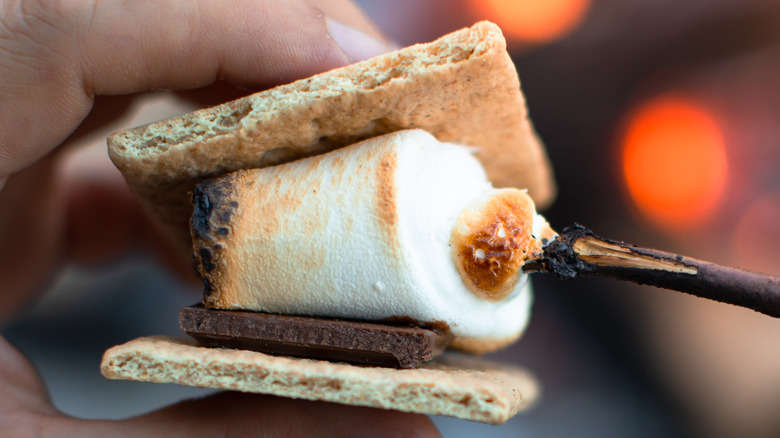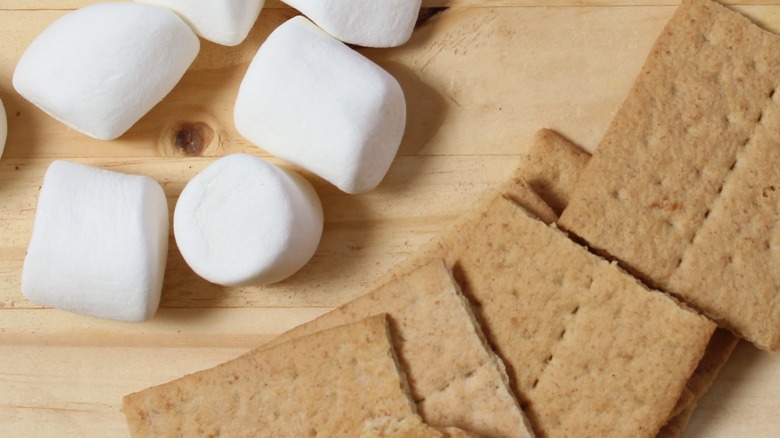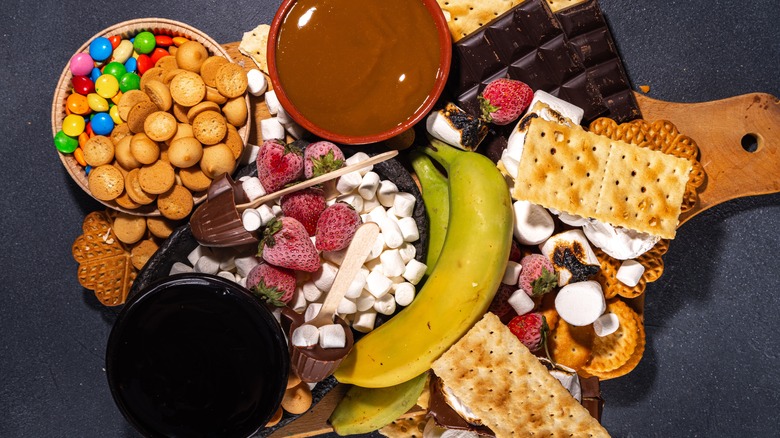You Can Thank The Girl Scouts For The First Official S'mores
We may receive a commission on purchases made from links.
Making s'mores has become a firepit tradition, like roasting hot dogs and sipping hot chocolate. But, where did this tradition come from? The Girl Scouts are responsible for publishing the first definitive s'mores recipe in 1927 in "Tramping and Trailing with the Girl Scouts."
The recipe was called "Some More," and its creation was attributed to troop leader Loretta Scott Crew. An August 1925 newspaper, the Memphis Commercial Appeal, included the recipe in its News From Kamp Kiwani at Hardy — a Girl Scout Camp, so it's clear the dessert was being made by the troops before the recipe was published. Then, the name s'more appeared in the 1938 "Recreational Programs for Summer Camps" by Henry William Gibson.
There are a few places where Crew may have gotten the idea for making s'mores with her scouts — after all, marshmallow roasting was a popular activity in the late 1800s. Some early 1900s American cookbooks called for confectionary sandwiches made with marshmallows and chocolate. Then, in 1913, Mallomars, featuring graham crackers and marshmallows dipped in chocolate, were introduced — with MoonPies on their heels in1917.
Publishing the recipe isn't the only way that Girl Scouts have contributed to s'mores. The organization also sells s'mores cookies. Selling cookies has been part of fundraising for Girl Scout activities since 1917, but you don't have to wait for the January-to-April selling season to enjoy the treat. It's easy to make s'mores at home or while exploring the great outdoors in proper scout fashion.
The origins of marshmallows and graham crackers
Circa 2000 B.C., Egyptians were the first to enjoy marshmallow as a syrupy medicine from the sap that they derived from the roots of the Althaea officinalis (mallow) plant, which is native to marshy areas in Northern Africa and Eastern Europe. But it wasn't until the 1800s that French candy store owners used the plant sap to make marshmallows, and the treats became so popular that they had to manufacture them.
After marshmallows spread to the United States, Greek immigrant James Doumakes and his son, Alex, founded the Doumakes Marshmallow Company in 1921. They greatly improved the manufacturing process, creating and patenting the extrusion process in the 1950s, so marshmallows could be cut and packaged in small pieces. This contribution made marshmallows more affordable, and although marshmallows are made with gelatin today instead of mallow root sap, they remain a hit worldwide.
Meanwhile, in the 1800s, health reformer and clergyman Sylvester Graham developed a bland cookie-like cracker as part of a list of lifestyle changes to reduce sexual urges. Since he didn't patent his recipe, though, author J. Thompson Gill was able to offer a sweeter version with molasses in "The Complete Bread, Cake and Cracker Baker," published in 1881. Today's graham crackers were first mass-produced in 1898 by Nabisco (called the National Biscuit Company at the time), and its sweet Honey Maid brand has been enjoyed since 1925.
It's easy to spice up your s'mores recipe
One of the best things about simple recipes, like s'mores, is how adaptable they are. There are plenty of creative ingredients you can include in your s'mores to make things exciting. A few top picks are peanut butter, brownie brittle, pretzels, or caramel syrup. You can even substitute milk for dark chocolate or your favorite candy bar. If you want a really exceptional s'mores experience, consider layering in the best fruit for a delicious bite, or try bacon, Oreos, potato chips, or chili powder. Use cookies in place of graham crackers for a totally new experience.
On top of that, you don't have to roast your marshmallows over a fire to make s'mores. You can get that same campfire experience by heating your s'mores in an air fryer, a technique popularized on social media. Like the traditional recipe, after roasting in the air fryer, the heat from the toasty warm marshmallow melts the chocolate, creating the sweet, gooey, and crunchy dessert that we've all come to love.



